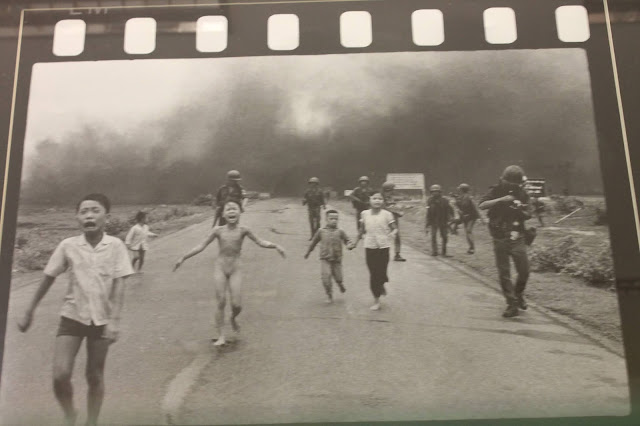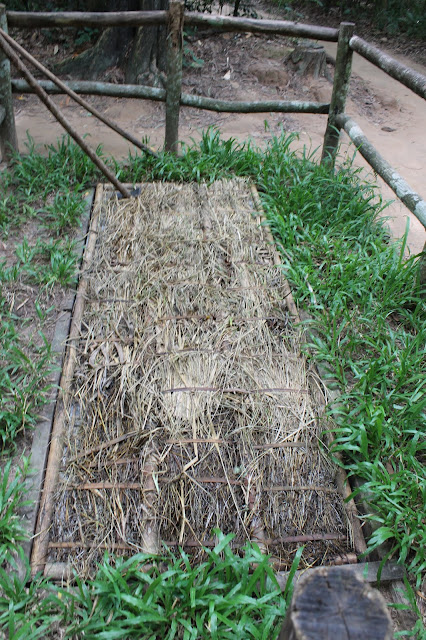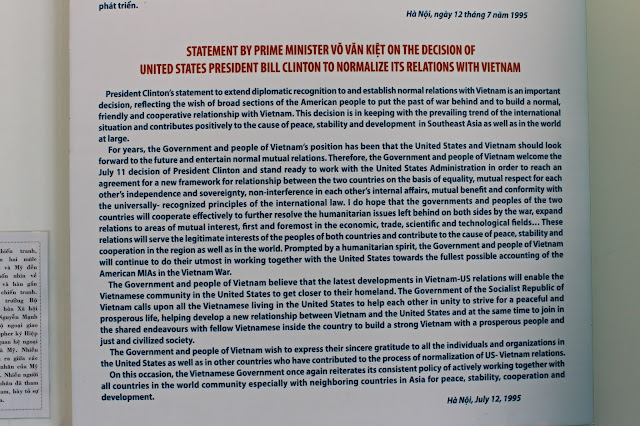Talking of travels an online friend suggested that I must share some
of my more memorable visits globally and so here is the first one in this
series of Travelogues. This is from Vietnam and the visit was in June 2013.
For most who have had a sense of history, especially American, the Vietnam war was the most famous. A giant of a country like USA had attacked
a small puny country Vietnam to save the country from communism. The war
stretched for around 10 years, and finally public outcry in USA forced the USA
to pull out. The enduring image of that war was this.

The popular opinion was that the USA had been brutal,
excessively violent, and the Vietcong in spite of this had survived and prevailed, in an unjust war. This piece is not to debate the war or who was right but to
share what I saw when I got a chance to visit the jungle area museum – called
Cu Chi Tunnels - where even today Vietnam has honestly displayed the horrors of
the war. This is just that – sharing images of the horrors in that war and to
speak of the ingenuity and fight back. To me after this visit my view was – it
is not about who started what first, or who was right and wrong, but the
brutality was not one sided. Every human who was targeted suffered –
immeasurably.
When one reads of American men in uniform who even today
are called Vietnam veterans and why they are so special, this visit explains
what they escaped or went through, if they survived. When I visited I was given
strict instructions not to stray even a foot from the path laid out and absolutely
no wandering in what looked like a lovely forest to walk around. Forget mines,
the place was the most brutal death trap of a place. So to my American friends I would say - Next time you see a car with Vietnam Veteran written on it, don't dismiss it. That, is a badge worn for a reason.
Like with most things even today, the American is the big
burly chap and where a fly swatter will do, will use a hammer, where a stick
would do, will use a missile and the focus is on technology. They faced in this
war, an enemy who was puny, had no technology. The proverbial rat versus elephant
fight and in the end the rat won. Looking at the area, one in hindsight feels
that the Americans had no chance of victory and their frustration could be gauged by the way they simply carpet bombed the
place down.
The tiny Vietcong were so small, as these pictures will show, they could in a flash go underground and disappear. A chap actually
demonstrated it and if he was not demonstrating, the speed with which he could
disappear was literally in seconds.
 |
| The Tiny trap door that merged with the jungle floor |
 |
The soldier jumps inside it in a flash
|
 |
| The soldier drops in like a stone silently and swiftly closing the door above his head |
 |
| Nothing left behind to easily notice in the jungle and the Vietcong who had just killed your fellow soldier had disappeared like a ghost |
And this into a hole that was so small that
even a fairly short person like me could not even try to fit in. A soldier
would hear a rustle and by the time he turned, the rustle would be silence and
nothing to see except dead leaves on the ground. More often a stealthy approach
from behind, a soldier quickly killed and before others could turn at the noise,
total silence and like a ghost the attacker would have disappeared.
There were many variants of such booby traps and were
laid out across the jungle floor and each created an unimaginably painful
horror. If one was like a folding chair that trapped one like between a
crocodiles jaws pierced all over, another was like a window which meant that a
large bodied soldier was trapped in more ways than one. In the rolling trap the
fallen soldier was impaled multiple times as he slipped down from
head to toe with the spikes moving in an out.
 |
| A well where as the victim went down the sharp spikes impaled victim from all sides & tore them apart |
 |
| Here it not only tore a person apart but trapped him hanging midway |
 |
| Here again the victim was shredded from bottom to top as he slid down due to his own weight |
 |
| In this the victim was also stuck half in and half out in a tiny place |
 |
| Here the victim was trapped like in a pincer hold |
Those who thought that searching a house was easier, they were mistaken. An old woman or child sitting outside would in fear allow the
soldiers to enter their homes to be searched, knowing what lay behind the
closed door. The moment the door was opened a trap would swing down in 2 halves
and impale the soldier in critical places. In every case death was never
instantaneous. It was always most agonising and prolonged.
 |
| The victim opens a door only to be impaled from below but if he thought he was smart and stepped back a second one at a higher level came crashing down to impale his face/neck |
As many would have read the Cu Chi tunnels, a huge
labyrinth of tunnels in Vietnam used by the Vietcong was around 120 Kms length
and shows the level of determination, intelligence, engineering skills and ingenuity
that’s amazing.
When such traps didn’t kill the soldiers, a plethora of
guerrilla tactics using the tunnels were used. For example a stream flowing would have a tiny hole in the side that at best would allow
a dog or fox to crawl into and not easily seen by anyone walking by. As the
American soldiers crossed the stream, Vietcong would crawl out from these holes
and shoot the soldiers from the rear. As the soldiers ducked for cover, dived
on to the grounds, they would escape back into the tunnels. Convinced that they
had somehow missed the Vietcong as they crossed, the soldiers would
cross back only to be again shot down from the rear. Often their enemy was unseen.
 |
| Entrance to a tunnel |
 |
| Entrance/Exit on a side embankment in a river/stream or path through which Vietcong appeared & disappeared like a rat in a flash |
 |
| Another entrance/ exit |
 |
| Yet another entrance/exit that one just could not see or even if seen ignored. Nothing bigger than a dog can even go inside here |
 |
| The way the entrance to a tunnel looks like, but back then it was without all the clear markings |
 |
| A entrance as it looked in a jungle path |
The entrance to these tunnels were not just tiny, but also
very well camouflaged. I had to literally crawl through the tunnel feeling
claustrophobic but yet the Vietcong seemed to navigate these tunnels with
speed. Their entire life was below the ground in these tunnels – be it living,
cooking, working. Often as shown, the entrance would be just a hole in the ground and as one can imagine a jungle will have a million such
holes. Given their small size it would have been next to impossible to identify
a hole as actually an entrance to a tunnel.
 |
| In many places as one travelled in the tunnels you had to literally crawl |
Bereft of arms and ammunition, theVietcong collected every shred
of bomb, other metals that the Americans had used and then used those to create their
own arms and ammunition. Now be it these forgings or even cooking there would
be fire and smoke. Technology meant that the Americans could notice this smoke
even from the air and bomb the place. So what was the solution ? Sheer genius.
 |
| American ammunition collected were converted into spikes, weapons |
 |
| Bamboo sticks being sharpened |
The entire smoke from a day long cooking would be led out
from the kitchen/ workshop tunnel area to another closed tunnel room where it
could fill up. From this place there would be tiny pipes that led up into the
atmosphere and ended in an ant hill or a tiny exit hole from where the smoke
escaped, at a rate not more than what an incense stick would emanate. Apparently, the smoke
created in one hour of cooking would take 24 hours to seep out of the ground into
the atmosphere. For any technology to
try and locate an incense stick sized smoke in a jungle is sheer impossibility. In professional engineering parlance this is called FMEA.
 |
| Cooking and dining areas as they were underground |
 |
| The anthill from where the smoke finally came out |
 |
| The exhaust hole in the ant hill |
 |
| A tiny trap door from which the smoke escaped so slightly that even standing in front of it, was not easy to notice |
 |
| Standing next to it this is how the exhaust trap for smoke looked like |
As one finished
the tour I realised that the Americans fought a war they had no hope in hell of
winning. If one were to point fingers at the Americans and the Napalm bombing
and such other stories that photo journalists and others have widely spoken
about, how the Vietcong suffered, it is important to realise that American
soldiers also suffered immeasurably. For many deaths caused by bombing, many
Americans died horribly and if they lived, life would have been an eternal
hell. However much it sounds easy and even justified to point fingers at the
Americans for their bombing and violence, it would be a travesty of justice if
one does not accept that they also suffered hugely and for long. If the local
populace suffered horribly, so did the American soldiers.
 |
| Reading the caption below the photo is self explanatory |
 |
| Just read the captions below the picture |
 |
| Any war is brutal |
Brutality was common and as the pictures indicate, many a
human in war can become worse than animals and benumbed. But to be like an animal in war, one need not always
be a soldier. A photojournalist is also equally involved as they acquire fame,
name, wealth based on how lucky they were to witness a particularly brutal
moment in human tragedy.
 |
| The work that a non combatant does on the battle field honestly explained as you can read from the caption below the picture |
If statistics are to be any reference point the number of Vietnamese
who suffered were likely a hundred times more than the Americans. In the end, all war is brutal and when it
means boots on the ground it becomes hell.
Whoever one may blame for starting a
war, the fact is both sides suffer greatly depending upon how much of humanity
they show or forced to not show. There are no easy answers. The report linked
below gives a tiny glimpse into that aspect by referring to the incident mentioned earlier in the picture "Any war is brutal".
https://www.carnegiecouncil.org/publications/articles_papers_reports/106
The communication between the countries then and much later in 1995 when finally the two countries resumed a relationship. The grace, maturity and statesmanship of the letter of 1995 is worth noting.
Walking the streets, one felt surprised at the level of cleanliness and there were many more beautiful and lovely sights one saw during the visit. One thing that stood out was, that there were far more women working, manning shops, walking around and someone told me that the war had left behind too many women. That’s likely why the population of men in Vietnam is lower than women.
 |
| Looking down from the Saigon Sky deck this looked like Paris with its Siene and very lovely |
 |
| Women were working, earning, running business in most places |
As I walked and glanced at a group of young girls, they decided to give a pose and I clicked this picture. The only thought in my mind was that these young girls showed confidence about themselves and their future, which they deserve. 8 years later today, I wonder what each of them are doing.
In the end, the idea here is to neither justify, comment
or opine on anybody, any country or any policy but to just showcase what one
saw on the visit. If at all one were to have an opinion then I think it is that
the Vietnamese have been far more open and honest in showcasing history than
what one would expect. They seem to have truly moved on.
 |
| Prayers in a place of worship that even had the Indian triumvirate Brahma, Vishnu, Maheshwara displayed |
 |
| The opera house and garden |









































Comments